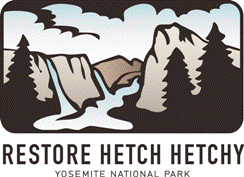As expected,
Gov. Brown has declared a
statewide drought in California. We’ve had dry years and even droughts before,
but nothing that compares to a winter this dry (so far) since 1977.
There’s only
so much we can do once we’re in this mess. In our cities, we will cut back, take
short showers and let our yards go brown. In the Central Valley, many fields
will go unplanted - causing economic hardship and increasing food prices.
The Governor’s executive order does do a few things. It includes provisions to streamline (pun intended) water transfers - the market-based sale of water from one user to another. Transfers can be complicated, physically and politically, but when done right transfers provide a powerful economic incentive for efficient use while reducing the pressure to increase diversions from our rivers, streams and wetlands. But the appropriate processing of and guidelines for managing water transfers should be in place permanently, as executing them on a piecemeal basis in dry years serves neither the planning needs of water agencies nor the public’s need to ensure natural resources are not harmed.
The governor’s
announcement describes the depleted state of
major reservoirs in California, comparing them to average levels. There are
a few things worth noting. First, the O’Shaughnessy Dam/Hetch Hetchy Reservoir
in Yosemite National Park is not included in this list. That is because every
stream in California’s Sierra Nevada is controlled by a dam that is much larger
than O’Shaughnessy. Second, the governor’s announcement does not show how much
water is available in our aquifers. That’s because we don’t know - in many
parts of California there is little or no control of who pumps out how much
groundwater.
Groundwater management
is a mixed bag in California. In 2014 as much as 40% of our statewide supply
may be pumped from underground. In some areas unsustainable groundwater pumping
will allow farmers to get by for another year (albeit with significant pumping
costs) but only will exacerbate long-term overdraft problems. On the other
hand, most of California’s urban centers have invested in groundwater recharge
by replenishing aquifers in Kern County and will be very glad they made those investments.
It may be
that the dire conditions statewide this year will be sufficient to inspire improved
regional and/or statewide solutions to the well-publicized over drafting of our groundwater
basins. Keep your eyes on places like Stanislaus County, where recently
hired Water Resources Manager Walt Ward will need to address lawsuits that challenge permits to drill of new wells.
The drought
may also encourage cities to move more aggressively on their plans to increase
the recycling of wastewater. To date, we have mostly seen recycled water put
into “purple pipe” – to be used only for irrigation and industrial uses - not
for drinking. The game changer will be when cities recycle and fully treat
wastewater to potable standards (“Direct Potable Reuse”). Scientists and
engineers tell us that doing so is perfectly safe, and note that many
communities drink water today which is diverted downstream of other communities’
water treatment plants. But drinking recycled water is not yet approved by the California Department of Public Health or accepted by the public. When Singapore developed
its Direct Potable Reuse program, they enlisted the participation of elected
officials and celebrities in a successful public relations campaign. There is a
rumor that San Diego will be the first city in California to propose Direct Potable
Reuse, but it is being cautious for now. You can visit San Diego’s demonstration recycling
plant, but they won’t let you drink the water!
As for the
opportunity to Restore Hetch Hetchy in Yosemite National Park, we’ve always
insisted that restoration should not take place until replacement storage
and/or other water supplies are in place. Hetch Hetchy Reservoir of course is
not a source of water; it’s simply storage - about 12% of the total surface storage in the
Tuolumne River watershed. And there are opportunities to replace that storage - such
as expanding the offstream Los Vaqueros Reservoir or investing in the Semitropic Water Bank.
But while
Hetch Hetchy is a medium-size reservoir by California standards, it’s the
greatest blemish in all of America’s national parks. It was taken from the
American people 100 years ago and it is time to give it back.
Let’s hope
for a silver lining in this year’s drought. While 2014 looks to be a tough year
from a water supply perspective, it may provide the incentive we need to reform
and improve our water systems. And with right improvements, we will be able to
restore Yosemite’s Hetch Hetchy Valley.



Nice insights. Hard times focus our attention on making needed changes. Droughts have always had this function in California for water management. We will have to see what comes of this drought. The implications developed here for Hetch Hetchy seem spot on.
ReplyDeleteLess water statewide is certainly a reality. If the label "drought", rather than natural order of ebb and flow, get's the attention of powers that be to the benefit of water conservation all the better! Recent blog comments of the relative value of reservoirs vs other means to store water instills in me even greater inspiration that our goal of valley restoration is near. Jim Ross
ReplyDelete